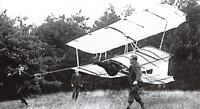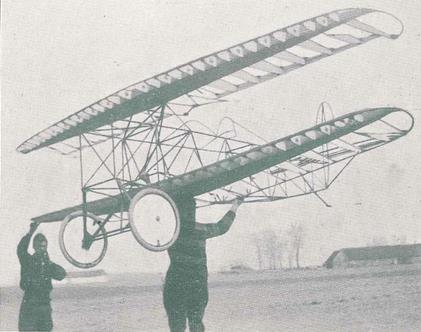B
During adolescence built and designed Pelzner model aircraft with such success that he had to deliver the aircraft to a local sporting goods store in his hometown. He broke the world record for model aircraft and was an instructor in the local flight school. In 1918 he was forced out in the First World War . When peace came, he studied physics, chemistry and mathematics at the University of Erlangen. With contributions from Nordbayerishe Luftsportverbund he could build a double-decker hang glider in full scale. 1920 he took part in the air races at Wasserkuppe with his glider and won the Fokker price and Rumplerprice . Pelzner got to know Douglas Hamilton summer of 1923, and the two pilots found each other. They drew up plans for the Hamilton Sound flight later in the year, and Pelzner came with the Helsingborg to prepare the aircraft. Among other things, he sealed the fuselage so that it would withstand a water landing.
In the early summer of 1925 Pelzner returned to Sweden with his self-designed flying wing and a Pelzner Simplex Sitzgleiter , to become trainer in Pelzner and Hamilton civilian flying school. The school was founded in Halmstad and for the first flights were built locally a Pelzner P 1 , which was a double-decker hang glider with variable wing area of 12-16 m 2 . Later, it came to be replaced by a Pelzner P 2 glider . In addition to the P 1 and P 2 was also used Hamilton's Espenlaub E 4 and a midwinged mono glider Pelzner P 4 built in Halmstad during the year. After the school moved around between Gothenburg and Vitemölla on Osterlen, the company established itself in autumn 1926 at Hammars hills just east of Ystad , where Pelzner was the first flight instructor. Here designed and built his first airplane Pelzner P 70 . The aircraft was high winged and wing-land could be turned 90 degrees to facilitate transport by car on normal roads. The span was 10.4 meters and the aircraft was equipped with a 2-cylinder motorcycle engine at 16 hp. January 24, 1928 will Nils Söderberg to perform CAA flight tests. Since the clearance between the wing and the cockpit was very limited could not Soderberg get into the aircraft without first wing was mounted away; event of an accident , he would have been stuck. The technical inspection and approval was made February 27, 1928 by Henry Kjellson .
In 1929 designed Pelzner and Hamilton aircraft P 158 H II which stands for Pelzner 158 and Hamilton second aircraft was a monoplane with wing mounted on a short gondola that was attached to the fuselage upper side. As the engine was elected a Douglas motorcycle engine 16 hp, the span was 9.5 meters, the wing surface 14 m 2 and an unladen weight of 110 kg.
During 1930 decided Pelzner and Hamilton to go their separate ways, and Pelzner drove school on alone. He designed and built the aircraft Cuckoo which was a high winged airplane with an open welded tubular construction as fuselage. He launches into a partnership with Lennart Hemminger and they together form the Aeronautical Research Institute Aeolus where they would construct and test new aircraft before flight exhibition ILIS in Stockholm in 1931. The first design was TP 171 a small double-decker equipped with a two-stroke Hirth engine of 24 hp. The wings were built of plywood on wood beams while the fuselage consisted of a welded tubular steel construction. Until 1935, he had had time to construct 227 gliders and sailplanes and three airplanes.
1935 Pelzner sold its assets in Sweden to Hamilton and returned to Germany, where he occasionally worked as a flight inspector. He studied at the Aeronautical Research Institution in Adlershof in Berlin , and got after graduation work as technical director at an airplane factory in Neubiberg . 1938, he was drafted into the Luftwaffe as Flieger-Hauptingenieur and became technical director of the Luftwaffe Luftflotte 3 in Munich . He was transferred in 1939 to the same service in Wiesbaden and from 1940 in Norway as a technical advisor to the head of the German air force in northern Norway and northern Finland. In 1942 he was assigned as a staff engineer to the Techniches Amt, Berlin . After the war , he worked with Wolf Hirth in Nabern-Teck to solve the problems of the flying wing. After retirement in 1962 he pursued research and design work with muscle-powered aircraft.



